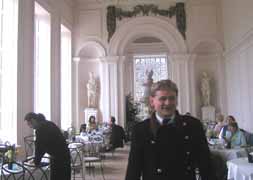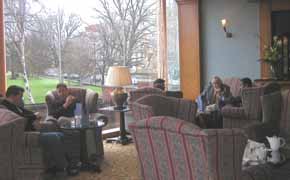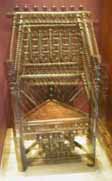Exhibition Reviews
| Home | | Museum Guide | | International | | Theater |
Lucy Komisar 's travel notes
Visiting Kensington, a chic residential corner of London
By Lucy Komisar
 |
| Orangery of Kensington Palace, London. Photo by Lucy Komisar. |
LONDON -- Where would you want to live if you lived in London? What neighborhood has elegance, charm, sophistication and also sense that it's for real residents, not for tourists, nor for moguls or diplomats or businessmen on expense accounts? Where do you get a sense of community, but also a location near some of the museums, royal landmarks and parks that London is famous for?
My choice would be Kensington, an upscale neighborhood in West London, just south of Hyde Park, close enough in fact to walk to the park, as well as to Royal Albert Hall, the Royal College of Music, the Albert and Victoria Museum and especially to Kensington Palace, which was the home of Diana, Princess of Wales. (Kensington was her neighborhood.) In the open spirit of the Brits, most of Kensington Palace is thrown open to tourists to see the state apartments and exhibits.
This is "The Royal Borough of Kensington and Chelsea," and the main street is Kensington High Street, a thoroughfare of shops and restaurants which turns into Kensington Road as it runs along the southern border of Hyde Park. The area is served by three tube stations, so it's easy to get to anyplace else in London.
Kensington, originally a Saxon settlement, is mentioned in the Domesday Book - a real estate record of 13,418 settlements in England commissioned by William the Conqueror in 1085 -- as a manor granted to one Aubrey de Vere, and the family remained Lords of the Manor of Kensington until the 16th century. William III moved into Kensington Palace in 1689. Its chic status was confirmed in 1704 when John Bowack wrote that it was "inhabited by Gentry and Persons of Note." He remarked on the presence of shopkeepers and craftsmen. The future Queen Victoria was born in the palace in 1819 and lived there until she took the throne in 1837.
Kensington became even more fashionable as the result of the Great Exhibition that opened in1851, held in the specially-built "Crystal Palace" in Hyde Park. With the profits, the exhibition commissioners bought an estate of 87 acres in South Kensington and made it a center for institutions of the arts and sciences. You will want to visit them. When the underground train from the City was extended to Kensington in the 1860s, homes in the area became even more desirable.
Where then to stay in Kensington? It's possible to book rooms with some history. On a recent trip, I sampled two places, one an intimate "boutique" mansion at a popular crossroads, the other a grand hotel overlooking Kensington Gardens. And there are plenty of bed-and-breakfasts in the painted white houses that line the residential streets.
The Radisson Edwardian Vanderbilt Hotel on Cromwell Road in
South Kensington is a row of ten five-story Victorian townhouses originally
built in 1871 for wealthy and influential people who did not want to live
in polluted central London and moved to the green fields of Kensington. The
arrival of people fleeing the French revolution of 1870 led also to French
influences, remarked in the Vanderbilt houses. That name was given in 1924,
a time when it was not unusual to name hotels after renowned families - in
this case, the American tycoon, Cornelius Vanderbilt, who had built a transportation
fortune in the 19th century.
The houses were converted to a stylish 213-bedroom hotel, but still have the intimacy and luxury of their former life, emphasized by a hideaway with leather chairs and couches, a homey breakfast room, and, more soignée, the stained glass windows, painted ceiling, and 18th century paintings on the walls. Soft sounds of Ella Fitzgerald and Billie Holiday waft through the lounge, with its tortoise shell bar. In a bedroom of elegant dark wood furniture, a red spread boasts the British lion and the red carpet features a white heraldic shield.
 |
| The Royal Garden Hotel, London. |
For more traditional splendor, I tried the Royal Garden, whose marble floors and plush lobby enhance the brass statue of a royal bugler. But there's plenty of modern: you can get emails at guest@royalgardenhotel.co.uk. And this hotel is one of the first in London with wi-fi internet access! Upstairs, the spacious bedroom features a relaxing platform nook that overlooks Kensington Park. From that perch, I could see cyclists, joggers and strollers and the gilded gates of Kensington Palace, the gold Albert Memorial statue and the dome-shaped Royal Albert Hall.
Downstairs, a stained glass ceiling hovered over the sumptuous breakfast buffet that included my favorite fresh figs. The two marble statues holding up the ceiling seemed to peer through the wall of windows, across to Kensington Gardens and the palace.
The palace today is the residence of the Queen's cousin Prince Michael of Kent and his wife; the Duke and Duchess of Kent; 100-year-old Princess Alice and her son and daughter-in-law, the Duke and Duchess of Gloucester. The Queen's sister, Princess Margaret, lived there until her death in 2002. The tenants pay only £115 a week, less than $185, which has to be better than New York City rent control! Through the hotel window, one can occasionally see a car driving down Palace Avenue, the private road to the royals' entrance to their apartments.
I paid a visit there, not to the private apartments, of course, but to the public part of the palace, with its formal gardens and corridors of rooms with ornate painted ceilings, gilded furniture, heavy chandeliers and mannered portraits of ancestors. There are both live and audio guides to the state apartments and the permanent collection of 14 evening dresses worn by Diana.
There is also always a special exhibit. I saw the 19th and 20th-century royal wedding dresses. The accompanying text included surprising frankness, pointing out that, in past centuries, seamstresses, huddled at work, 40 to a small garret, often went blind and lived to only 25, asobering thought among the glittering beauty of the beaded and bejeweled garments. Now, till April 2004, the Queen's hats and handbags are on display, including 100 items of headwear worn to the Ascot races and garden parties and on state occasions, along with corresponding handbags and gloves.
After a traipse through the palace, a charming place for tea and delicious scones is the airy Orangery, where the Windsors (the Queen's family) actually grew orange trees, and which is still used for royal receptions and also for charity and corporate functions.
It's an easy walk from there through Kensington Gardens to the Albert Memorial statue erected in 1872 in memory of Prince Albert, the German husband of Queen Victoria, after his death 11 years earlier. Then south across the street to a grand collection of museums and performance spaces, most of which date from the famous exhibit of 150 years ago.
The red-brick domed Royal Albert Hall is where the famous "promenade" concerts are held; you can buy a regular seat, but students and adventurous adults buy the standing room in the pit, and then they unceremoniously sit on the floor. I was there once on the last "prom" of the summer season when everyone at evening's end traditionally belts out a riotous, raucous version of "Rule Britannia."
I stopped into the Royal College of Music across Prince Consort Road and, on hearing the sound of some modern atonal composer, discovered that you can attend rehearsals there Mondays from 11 to 4:30. The college also has a museum with over 700 instruments and accessories from 1480 to the present, open to the public from 2 to 4.30 on Wednesdays during the school term.
 |
| An antique chair in Victoria and Albert museum |
From there, I walked a block south to the Victoria and and Albert Museum, the national exhibit hall of art and design, and - choosing just a corner of its 10-acre expanse - wandered through the British Gallery. I loved a display of photos from the famous London Exhibition. There's also a carved bed from 1590, the front of a 17th-century house, and costumes that date to the 16th century. Kids will like the interactive exhibits. Across the street, I passed the museums of science and natural history, but -- too much for one afternoon.
Time for refreshment. A short walk, and I stepped into Olives, the pub at Bailey's, a perfect choice, because this hotel is also Victorian. The characteristic 1876 red-brick building features large marble pillars, a grand staircase and stained glass windows. And the pub, with light wood paneling, cushy leather arm chairs and couches, and soft jazz, offers more succor than the ordinary beer spot! At least, I never found its delicious rosemary chicken or prawns and plum sauce in any traditional pub. Sometimes, it's good to go modern!
The Radisson Edwardian Vanderbilt Hotel (4 star)
68-86 Cromwell Road
South Kensington
London, SW7 5BT
44 (0)2077619000
Fax 44 (0)20 7761 9001
Toll Free: (800) 333-3333 US
Toll Free: (0800) 37 4411 UK
resvand@radisson.com
http://www.radisson.com/londonuk_vanderbilt
(The hotel offers 10 minutes on internet free; there's no charge to use
or print from the computer, which is available 24/7.)
Single £195 ,
Double £222
vat is 17.50% extra
Royal Garden Hotel (5 star)
2-24 Kensington High Street
London W8 4PT
44 (0)20 7937-8000
fax 44 (0)20 7361-1991
toll free USA 800 987-9317
Single £ 245
Double £305 up
vat is 17.50% extra
http://www.royalgardenhotel.co.uk/
Olives
Millennium Bailey's Hotel
140 Gloucester Road
London SW7 4QH
44 (0)20 7373-6000
baileys@mill-cop.com
Kensington Palace
Open daily: 10-6
Last admission: 5
44 (0)870 751-5170
www.kensington-palace.org.uk
Gate price £10.50; £7.00 and £8.00 for students and seniors
booked by
internet or phone
Royal College of Music
Prince Consort Road
South Kensington
Just south of Royal Albert Hall.
http://www.rcm.ac.uk/
Museum of Instruments. £1.20
Groups and special visits by appointment: museum@rcm.ac.uk
Victoria and Albert Museum
Cromwell Road
South Kensington
10 to 5.45 Daily
10 to 10 Wed and last Fri of month.
www.vam.ac.uk
The Royal Borough of Kensington and Chelsea
http://www.rbkc.gov.uk/
http://www.kensington-chelsea.com/
[Komisar]